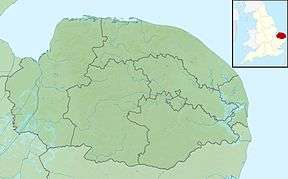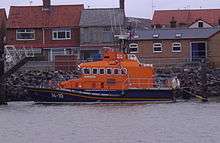Great Yarmouth and Gorleston Lifeboat Station
Great Yarmouth and Gorleston lifeboat station (not to be confused with Yarmouth on the Isle of Wight) is a RNLI base in Norfolk, England. There were originally two separate stations at Great Yarmouth and Gorleston – two coastal towns either side of the River Yare. These were merged in 1926.
| Great Yarmouth and Gorleston lifeboat station | |
|---|---|
 Great Yarmouth and Gorleston lifeboat station | |
 | |
| General information | |
| Type | RNLI Lifeboat Station |
| Location | Great Yarmouth and Gorleston lifeboat station, Riverside Road, Gorleston, Norfolk, UK |
| Country | England |
| Coordinates | 52°34′31.51″N 1°43′55.34″E |
| Owner | Royal National Lifeboat Institution |
History
Great Yarmouth
Great Yarmouth received its first lifeboat in 1802. It was never called out.[1]
In 1825 the Norfolk Association for Saving the Lives of Shipwrecked Mariners stationed its first lifeboat at Great Yarmouth. The station was taken over by the RNLI in 1857 and in 1859 a new lifeboat house was built at a cost of £375. The station closed in 1919.[1]
Gorleston
The Gorleston lifeboat station was established by the RNLI in 1866. In 1881 a new boathouse was built at Gorleston for £329 and in 1883 a second boathouse (Gorleston No.2) was built alongside. This closed in 1926 when Gorleston No.1 station was renamed Great Yarmouth and Gorleston.[1]
During 1897 the station received its first steam lifeboat City of Glasgow and during 1921 its first motor lifeboat.[1]
Great Yarmouth and Gorleston
In 1963 an inshore lifeboat station was established with a D class lifeboat that remained in service until 1978.[1]
In 1975 a B class Atlantic 21 lifeboat was sent to the station.[1]
During 1993 crew facilities were upgraded, a gift-shop built and a display area created for the former Gorleston lifeboat John and Mary Meiklam of Gladswood. The boathouse was further extended in 2002.[1]
In 1996 Princess Alexandra, The Hon Lady Ogilvy officially named the station’s new Trent class lifeboat Samarbeta, Swedish for ‘working together’.[1]
The current lifeboats on station are the Trent class Samarbeta and the B class Seahorse IV.[2]
Notable rescues
In October 1922 the Gorleston pulling and sailing lifeboat and the Lowestoft motor lifeboat, after a struggle lasting 32 hours, brought to safety the whole crew of 24 and a black kitten from the steamship SS Hopelyn wrecked on Scroby Sands.[1]
In 1927 lifeboats from Great Yarmouth & Gorleston, Cromer, Southwold and Lowestoft took part in the rescue of the Dutch oil tanker Georgia. This service is considered to be one of the greatest in the history of the RNLI.[1]
The lifeboat Louise Stephens was one of 19 lifeboats involved in the Dunkirk evacuation of 1940.[1]
Lifeboat disasters
The stations suffered four major lifeboat disasters between 1866 and 1888:[1]
- In 1866 twelve Gorleston boatmen died when their private lifeboat Rescuer capsized in a storm.
- In 1867 while returning to harbour after a rescue a fishing lugger collided with Rescuer. She capsized and six of her crew and 19 other people drowned.
- In 1881 six lifeboatmen from the Great Yarmouth lifeboat Abraham Thomas drowned when their vessel overturned in heavy seas while attempting to rescue a seaman from a stranded schooner.
- On 10 November 1888, four crew from the private Gorleston lifeboat Refuge drowned whilst on a rescue to The steamer Akaba. The 300-ton steamer was en route to Dundee loaded with Jute. The lifeboat with the aid of the other local lifeboat the Friend of all Nations, went to assist and managed to put some men aboard before the boat was smashed against the hull and lost her rudder. The boat with seven crew was taken under tow, but whilst entering Yarmouth harbour the rope became disengaged and she was washed onto North sands and then was hit by a big wave and capsized. Henry Smith Chief boatman of the coastguard was on the beach and without thought for his own life, managed to save two crew members Bonney and Woods. Whilst a boatman of the coastguard named Norton saved George Jacobs, who was clinging to the stern post. Aaron George was washed up on the beach dead and two days later the body of Samuel George was found washed ashore on the beach. William Whiley and one other man also drowned. The Yarmouth Independent newspaper report of the death of Jacob Philip Jacobs, dated 18th January 1913, states that he was one of the lifeboat crew who were saved. It is likely that Jacob Philip Jacobs and George Jacobs were the same person as the description of the rescue by the boatman are very similar.
Fleet

Great Yarmouth Fleet
1825-1919
| Dates in service | Class | Name |
|---|---|---|
| 1845 | Yawl | Phoenix |
| 1881 | Abraham Thomas |
Gorleston Fleet
No. 1 Station
| Dates in service | Class | ON | Name |
|---|---|---|---|
| 1866–1889 | The Rescuer | ||
| 1889–1936 | Elizabeth Simpson |
No. 2 Station
| Dates in service | Class | ON | Name |
|---|---|---|---|
| 1883-1924 |
No. 3 Station
| Dates in service | Class | ON | Name |
|---|---|---|---|
| 1899–1903 | Steam | ON 420 | James Stevens No. 3 |
No. 4 Station
| Dates in service | Class | ON | Name |
|---|---|---|---|
| 1897–1903 | Steam | ON 362 | City of Glasgow |
| 1903–1908 | Steam | ON 420 | James Stevens No. 3 |
Great Yarmouth and Gorleston Fleet
All Weather Boats
| Dates in service | Class | ON | Op. No. | Name |
|---|---|---|---|---|
| 1926–1939 | Elizabeth Simpson | |||
| 1939–1974 | Watson-class | ON 820 | Louise Stephens | |
| 1967–1980 | Waveney-class | ON 1002 | 44-003 | Khami |
| 1980–1999 | Waveney-class | ON 1065 | 44-021 | Barham |
| 1996–present | Trent-class | ON 1208 | 14-10 | Samarbeta |
Inshore Lifeboats
D-class
| Dates in service | Class | Op. No. | Name |
|---|---|---|---|
| 1963–1964 | D-class (EA16) | D-9 | unnamed |
| 1964 | D-class (EA16) | D-32 | unnamed |
| 1965 | D-class (EA16) | D-1 | unnamed |
| 1965–1967 | D-class (EA16) | D-73 | unnamed |
| 1967–1968 | D-class (EA16) | D-26 | unnamed |
| 1968–1969 | D-class (EA16) | D-113 | unnamed |
| 1970–1977 | D-class (EA16) | D-179 | unnamed then Blue Peter IV |
B-class
| Dates in service | Class | Op. No. | Name |
|---|---|---|---|
| 1975–1988 | Atlantic 21-class | B-531 | Foresters |
| 1988–2002 | Atlantic 21-class | B-574 | Joseph B Press |
| 2002–present | Atlantic 75-class | B-786 | Seahorse IV |
Honours
The station has been awarded 1 gold medal, 21 silver medals, 24 bronze medals, 5 vellum inscriptions and 9 framed letters of thanks.[1]
Over 100 lifeboat crew were given the Freedom of the Borough of Great Yarmouth in 1982.[1]
See also
References
- RNLI history of Great Yarmouth & Gorleston lifeboat station Archived 2009-01-08 at the Wayback Machine.
- Archived 26 August 2007 at the Wayback Machine
External links
| Wikimedia Commons has media related to Great Yarmouth and Gorleston Lifeboat Station. |